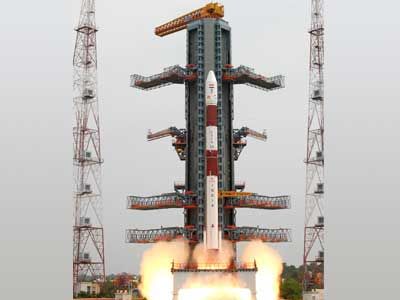 The Chandrayaan-2 will conduct the next level of scientific studies on the Moon, writes T E Narasimhan.
The Chandrayaan-2 will conduct the next level of scientific studies on the Moon, writes T E Narasimhan.
In what will be its next step to reach, land on and explore the Moon, the Indian Space Research Organisation is gearing up to launch its space science and planetary exploration mission, Chandrayaan-2, on a GSLV MKII launch vehicle, in the first quarter of 2018.
The Chandrayaan-2 spacecraft is a composite module consisting of Orbiter, Lander and Rover. Unlike the Chandrayaan-1, where Moon Impact Probe crash-landed on the surface of the Moon, the Chandrayaan-2 will soft-land its Lander with Rover on the lunar surface to conduct the next level of scientific studies.
Another interplanetary mission that ISRO is working on is the Aditya-L1, a scientific mission for solar studies carrying five payloads, including a Coronagraph. The Aditya-L1 is planned to be placed into a halo orbit around the L1 Legrangian point. These payloads taken together are expected to provide a comprehensive understanding of how solar flares originate and propagate.
Among other new satellites being built for meeting the country's future requirements include the IRNSS-1H, and 1I, which are planned to be launched on board the PSLV, GSAT-19 by GSLV-MKIII, GSAT-17 and GSAT-11 communication satellites through procured launches during the first half of 2017.
In the domain of earth observation satellites, ISRO is planning to design, develop and build three satellites in the Cartosat series by the first half of 2018, Oceansat-3 in the Oceansat series, RISAT-1A in the Radar Imaging Satellite series and GISAT-1 in the INSAT series for meteorological applications, in 2018.
To cope with the increased number of spacecraft - 10-12 every year -- Isro has to identify a vendor for handling spacecraft-level activities. A contract has been signed recently with a private player which leads the consortium of a few other players. This was the first time an Indian private industry player would be partnering the ISRO Satellite Centre in integrating satellites, said ISRO.
According to ISRO, standard spacecraft systems could be realised through Indian industry players in a production mode, after qualifying it to take up manufacturing of electronic and mechanical subsystems and fabrication at subsystem levels and test support.
ISRO would train the vendor for handling spacecraft-level activities. The vendor would provide technical manpower to ISRO in the first phase. Expert manpower from this partner would be actively involved in integrating two satellites using the infrastructure provided by ISRO.
A contract was recently signed with a private player that leads a consortium of a few others. All the hardware for the sub-systems of spacecraft, spare infrastructure for assembly, integration and testing of two repeat types of navigation satellites would be provided by ISRO.
The department of space has transferred about 300 technologies to Indian vendors for commercialisation and undertaken technical consultancies in various fields.
Technology transfer is an act of policy pursued by the department of space for over four decades.
Through this, the technologically advantageous results of in-house research and development in space activities performed by ISRO’s work centres are transferred to industry for various applications. The modes of technology transfer include spin-off for non-space applications, buyback/productionisation for continued requirements for space activities and space applications for taking the benefits of space technologies to society.
This year, 13 technology transfers have been made to Indian players in the areas of materials, chemical, adhesives, pressure transducers, earth station antenna, etc. Another technology, FEAST Software, a finite element analysis of structures software, is being used increasingly by the R&D institutions and universities across the country. To accelerate the usage of FEAST among the technical community, marketing licences have been awarded to two more agencies during the year.
Seven more technology transfers are in the pipeline.












 © 2025
© 2025